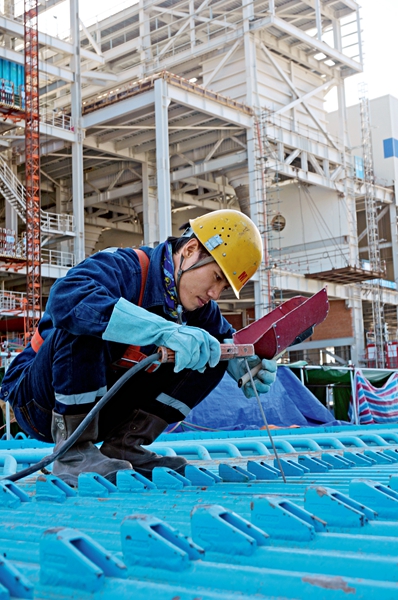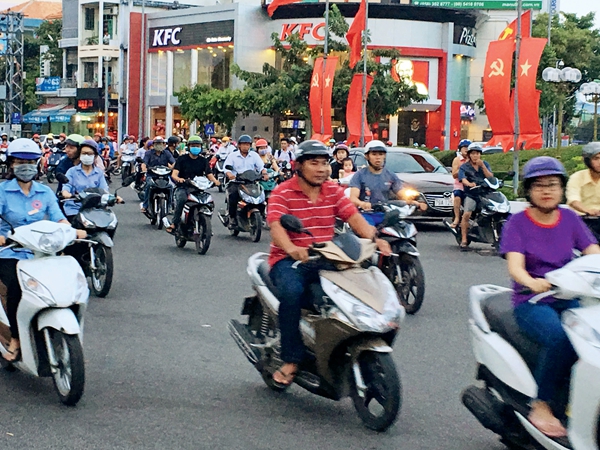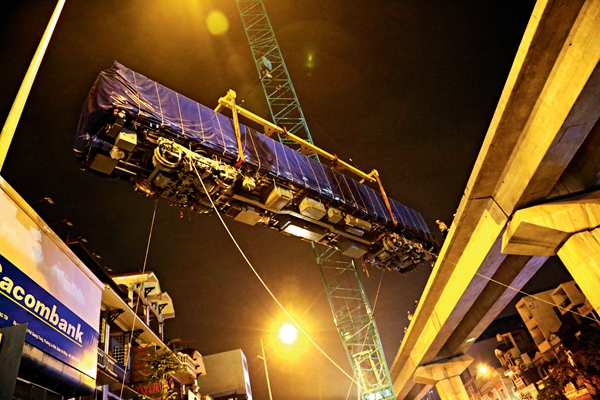By staff reporter ZHANG HUI
By staff reporter ZHANG HUI
CHINA has both land and sea borders with Vietnam. The Lancang River, whose source is on the Qinghai-Tibet Plateau, rolls down to the Indochinese Peninsula, where it becomes the Mekong River, and drains into the South China Sea near Ho Chi Minh City. China and Vietnam forged a profound friendship during their respective efforts to gain independence by extending helping hands to one another. The song “Vietnam-China,” composed by a Vietnamese musician, was hugely popular in both countries in the 1960s and 1970s. It stands testament to the deep bond between the two nations.

Throughout history, Chinese culture has significantly influenced life in Vietnam. Until the 1920s a logographic system of Chinese characters was used in Vietnam to represent Sino-Vietnamese vocabulary and certain native words. Since the turn of the millennium, both countries have deepened their domestic reforms. China’s development began earlier than that of its southern neighbor, and Vietnam has learned much from their cooperation in the areas of infrastructure construction, electricity, and manufacturing. China has been Vietnam’s biggest trade partner for 13 consecutive years, and Vietnam is China’s biggest trade partner in the ASEAN group. Tourism in Vietnam is booming, and China is its largest source.
As the Belt and Road Initiative continues to advance, China and Vietnam are expected to cooperate in even more areas. China Today’s correspondent joined a team of reporters from China International Publishing Group on a trip to Vietnam in late April. The common objective was to find out more about bilateral cooperation projects.
Evolution of a “Motorcycle Kingdom”
My first impression on hitting the streets of Vietnam’s capital Hanoi was that the country truly is a kingdom of motorcycles. Every lane and street teems with them, and they monopolize parking lots. I saw hardly any bicycles, and there seemed to be fewer cars on the road than in Chinese metropolises. “Almost everyone in Vietnam owns a motorcycle. It’s a staple form of transport to and from work,” Nguyen Thu Hang, a young Vietnamese woman working as a translator in a Chinese organization, told China Today. The average monthly salary in Vietnam is around US $300. This explains why the motorcycle is the most popular transportation choice.
Vietnam’s reform and opening-up drive began in 1986. Early on, its per capita GNP was less than US $100. It has since risen to beyond US $1,000. Since the turn of the millennium, Vietnam’s economic growth has on average, hovered between five and eight percent, and in Asia is second only to China. In 2005 the UN commended Vietnam for its balanced development, evident in its Gini coefficient being the lowest in Asia. It was thus perceived as a country whose people are relatively wealthy.

This fast developing country, however, is short on quality infrastructure. The inadequate highway network is marred by the poor conditions of its roads, the railway network serves mainly urban areas, and its urban rail transit systems are in their infancy. If Vietnam is to tackle and complete big infrastructure projects, it must attract foreign investment. According to the Saigon Times, Vietnam’s yearly capital demand for infrastructure construction is around US $25 billion. State and private investment contributes US $16 billion, leaving a shortfall of US $9 billion. Therein is ample scope for China-Vietnam cooperation.
The China Railway Sixth Group Overseas Branch Company built Hanoi’s light rail transit line 2, linking Cat Linh in the city center with Ha Dong in the south, with Chinese equipment according to Chinese technical standards. It is an inter-governmental cooperation project funded by a preferential loan from China.
“The material used for the transit line is top-grade, and after years of use in China’s multiple subway lines, the quality of the equipment installed has passed the test of time,” deputy general manager of China Railway Sixth Group Overseas Branch Company Sun Dezhi told China Today.
The rail transit line will greatly ease Hanoi’s frequent traffic jams and expand the city’s development space. “I get caught up in traffic congestion almost every day. The 15-minute motorcyle-commuting distance usually takes more than 25 minutes. Once the rail transit line comes into use, my commute to work will take only 10 minutes each way,” Do Duc Trung, a Vietnamese employee on the project, told China Today.
Wang Duo, chief representative of the Vietnam Office of China National Machinery Import and Export Corporation, has worked in Hanoi for seven years, and witnessed the city’s dramatic changes. “We wanted a quiet location for our office building and so came here (Trung Hoa Nhan Chinh, Thanh Xuan District of Hanoi). At that time our five-story building was the tallest in the area. But now, as you see, there are many, much taller buildings. Back then, there were hardly any cars. Since then more people have moved into the community, bringing cars with them,” Wang told China Today.
From Suspicion to Trust
The path has not run smooth for the Chinese company contracted to build the transit line project in Hanoi. “It seems we’re paying the price for some small, irresponsible Chinese manufacturers that traded inferior products in the past. When, in the early days of our Hanoi project, we proposed buying China-produced equipment, the response of the Vietnamese property owners’ committee was one of doubt and suspicion,” Sun Dezhi said. Although it’s an EPC (Engineering, Procurement and Construction) contract, the Chinese company needs approval from the property owners’ committee before any major procurement.
Made-in-China daily necessities and small household appliances first came into Vietnam in the late 1980s. But a profusion of cheap, poor-quality products produced a generally unfavorable impression of Chinese-made goods among Vietnamese people.
“For example, we selected a Chinese manufacturer for our procurement of an automatic ticket checking system. However, the property owners’ committee insisted that a system produced by a European company would be better. We agreed that the European system was good, but pointed out that it had never been used for a rail or subway transit line. After showing proof that the Chinese system had been used for 18 subway lines in China, and that no malfunctions had been reported, the property owners’ committee finally agreed,” Sun Dezhi told China Today.

When designing the rail track, the Chinese company adopted an energy-saving upslope for pulling into the station and a downhill one for drawing out. “But many people didn’t understand that this was an energy-saving design. Some asked, ‘Why do we have to have the slope design when the Japanese-constructed transit track in Ho Chi Minh City is straight?’ We did our best to explain the design to the property owners’ committee and the Vietnamese Ministry of Transport. But it was only when local experts gave it their public support that the committee finally bought the idea,” Sun said.
Last year, a music video clip with no voiceover shown on youtube caused a sensation in Vietnam. It compared pictures of the Japanese-built rail transit line in Ho Chi Minh City with pictures of the line in Hanoi constructed by the Chinese company, which clearly showed that the latter outperformed the former in almost every respect. And more importantly, that the Chinese-built line cost the Vietnamese people less than the Japanese track.
“That was when the mainstay of public opinion changed from doubt to the current anticipation of the line’s completion. Our Vietnamese employees also gave us full credit for the top-grade construction material used in the project. They said that some Vietnamese people considered the TOTO sanitary fittings used in stations along the transit line to be luxurious,” Sun said.
The Vietnamese government is now eminently satisfied with the Chinese-built rail transit line. It has already voiced its intention to cooperate with the Chinese company on building other rail transit lines when this one is finished.
Meanwhile, another China-Vietnam cooperation project, the Vinh Tan 1 power plant project, mainly funded by China Southern Power Grid Co., Ltd. and China Power International Co., Ltd., has also established its reputation in Vietnam, by virtue of its high-quality and professional construction work, scientific management, and effective environmental protection measures.
“Chinese people work efficiently, and their workers are highly skilled. That explains why the project is progressing so quickly,” the project’s independent engineering supervision director Nguyen Nhan Bao told China Today.
According to Xu Jinglun, the project’s deputy general director, the power plant will be the first in Vietnam to use the supercritical “W” flame boiler technology. This is expected to lower significantly the coal consumption needed for power generation, and reduce yearly CO2 emissions by about 20,000 tons. After it comes into operation the power plant will meet one sixth of southern Vietnam’s power demand.
Integration with the Local Community
“Our association frequently organizes trips for Chinese companies to Vietnam’s outer regions to donate supplies and so help with poverty alleviation. We have given children schoolbags and other school stationery. Some companies like ICBC (Industrial and Commercial Bank of China) and Midea have organized cultural activities in Hanoi University, like Chinese language and calligraphy competitions,” Wang Duo, who is also head of member enterprises of the Business Association of China in Vietnam (BACV), told China Today.
“Last year we donated about VND 3 billion to a local community to build a bridge,” Sun Dezhi said. “Our Chinese and Vietnamese employees get along well with each other. Last year, our Vietnamese chef’s child caught Dengue fever and was hospitalized, but more than VND 100 million was needed for his treatment. The next day we had a whip-around and all the Chinese employees chipped in. We raised more than VND 70 million which we took to the hospital that evening. Whenever a local employee of ours runs into difficulty, our company does what it can to help.”
The Chinese company also attaches importance to training local employees and technology transfers. According to Sun, since the project started construction in July 2015, the China Railway Sixth Group has successively trained about 7,000 Vietnamese employees. “When it came to building precast beams, we invited two skilled Chinese workers to join the project and train local workers with a hands-on approach. Local workers finally mastered the technique after a month of training,” Sun said.
The Vinh Tan 1 power plant project has hired Vietnam’s PECC2 (Power Engineering Consulting Joint Stock Company 2) as the engineering supervision company, and given employment priority to local technicians and workers. As of April, 2017, the project had directly employed nearly 3,000 Vietnamese workers. Meanwhile, local companies have also been approached for the procurement or lease of large construction machinery, appliances and auxiliary materials. This project has also created jobs in local communities in the catering, accommodation and other service sectors.
“The Vinh Tan 1 project is China’s first BOT (build-operate-transfer) power project in Vietnam. After its completion, the Chinese side will operate it for 25 years and then transfer it to the Vietnamese government. During the process, we will consolidate our training of local employees. Apart from concentrated training to acquire professional knowledge, we also send trainees to Chinese power plants to gain onsite skills,” Xu Jinglun told China Today.
Nguyen Van Thuong is a welder on the Vinh Tan 1 project. “I’m very happy to be working here, and receive pretty good pay, enough to support my family. The Chinese company sets great store on safety measures during construction. Since starting work here my skills have really improved thanks to my Chinese colleagues’ help,” Nguyen told China Today.
Meanwhile, the Vinh Tan 1 project has paid close attention to environmental protection, and tried to avoid any negative impact of construction on local residents. “The project is located in Tuy Phong County of Bình Thuan Province, which has a three-month-long windy season. To prevent dust pollution, we regularly sprinkle water over the construction site, and dust reticulation has been used to cover all exposed earth surfaces. During the season it’s windy almost all day long, and sometimes even escalates to a grade-11 gale. Our project noted this local climatic feature from the very beginning. We have taken all possible measures to prevent any environmental pollution,” Xu said. In contrast, inadequate precautions taken by a nearby local power plant project have reportedly caused dust flows to spread to the local community. This has seriously affected local people’s health. Protest demonstrations by irate local residents blocked the local transport artery Road AH1.
Closely Bonded Brotherhood
Geographic proximity and cultural affinities have contributed to even closer bilateral exchanges. There are in Vietnam 1,500 registered Chinese companies. China-produced groceries and daily necessities abound on Vietnam’s supermarket shelves.
Nha Trang, a coastal city in central Vietnam, is becoming a popular holiday destination for Chinese tourists. A manager of the Havana Hotel in Nha Trang, who requested anonymity, told China Today, “Around 70 percent of guests in the hotel are from China.” All signs in the hotel are in Chinese and English, as well as Vietnamese. Many of the hotel workers speak Chinese. Nearby markets heave with Chinese tourists, who can use Renminbi to buy almost anything. Many local vendors can even talk to you in Chinese.
“Before starting their jobs, our Vietnamese employees usually take a three-month course in Chinese. They can then carry on basic communication in Chinese,” said Xu Jinglun. Their rapid mastery of Chinese might be ascribed to similarities between the Chinese and Vietnamese languages. This harks back to former predominance of Chinese in Vietnam.
“As a supervisory company, we frequently experience cultural conflicts when supervising the investment projects of other foreign countries. However, this has not been the case in the Vinh Tan 1 project,” Nguyen Nhan Bao told China Today.
“Currently there is a Chinese language learning craze in Vietnam. The numbers of people learning Chinese in Vietnam are second only to those learning English,” Nguyen Thu Hang said. It was through learning Chinese that she met her Chinese husband. “Owing to the cultural similarity of the two countries, we’ve encountered neither communication barriers nor cultural conflicts.”
Vu Van Chinh is a translator and interpreter in a Chinese company in Hanoi. “My decision to learn Chinese was influenced by my family, but also prompted by personal interest. My grandpa could speak several languages, including Chinese, and excelled at Chinese calligraphy. My father also has a personal affection for China, as he worked with many Chinese experts, so they hoped I might choose to learn Chinese. I really wanted to learn more about Chinese culture, because as a kid I read the Chinese classical novel the Romance of the Three Kingdoms,” Vu told China Today. “Fluency in Chinese also increases job opportunities,” he added.
Although many ordinary Vietnamese people still have no comprehensive understanding of the Belt and Road Initiative, all those interviewed expressed confidence in the further enhancement of bilateral cooperation. “China-Vietnam relations are already close. As the two countries have reached consensus on further advancing their cooperation, I believe bilateral relations will continue to improve, and that more cooperation projects may be expected,” Nguyen Thu Hang said.